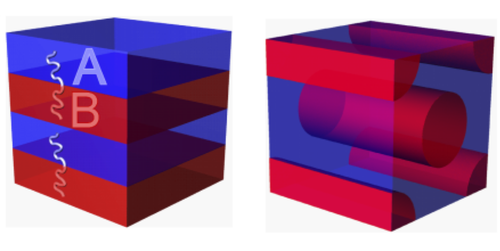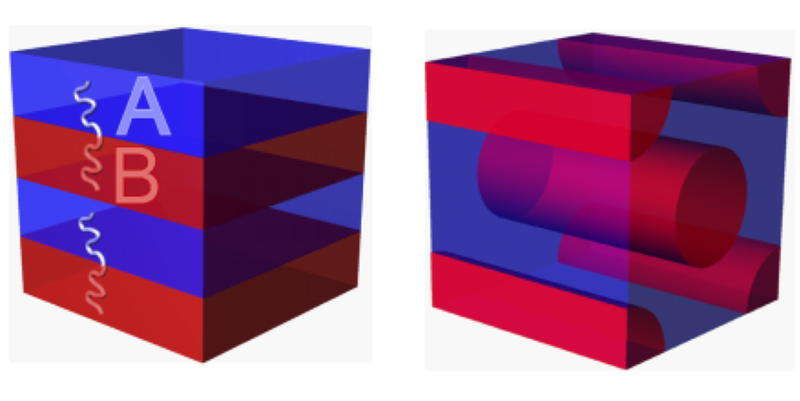Magnetic Field Aligns Polymer Structures
Polymers, which make up homogeneous materials like plastic and rubber, can also form materials composed of domains with shapes such as cylinders or sheets. Now researchers have shown that they can orient sheet-like domains using a magnetic field. Controlling the orientation of these domains is beneficial for the production of nanofiltration devices and advanced batteries that are part of "clean energy" technologies.
In order to incorporate the properties of two or more polymers into the same substance, researchers have developed “block copolymers.” One simple example is a long-chain molecule in which one half consists of repeated monomers of type A, and the other half consists of type B monomers—two polymer “blocks” bonded together. Under the right conditions, with many such molecules mixed together, each block tries to stay with its own kind. This affinity can produce various larger-scale structures, such as regions of alternating sheets of A and B blocks called lamellae or cylinders of A within a matrix of B. These so-called domains occur with random orientations, but aligning them can be useful. For example, if the domains are cylindrical, selectively dissolving them leaves channels behind, producing a nanoscale sieve. Aligning the cylinders maximizes the sieve's throughput.
Researchers have previously used electric fields to align block copolymer domains [1], a technique that relies on the difference in the electric field response of the two polymer blocks. However, the effect is weak, which means that strong electric fields are required, and these fields can damage the polymers.
A few researchers have also attempted to use magnetic fields to align domains, exploiting their so-called magnetic anisotropy—the difference in a molecule's magnetic response when comparing two different field directions. If a domain has a magnetic anisotropy, it will tend to align with a magnetic field in a specific orientation, but the magnetic anisotropy is often too small to produce a noticeable effect. Some researchers have instead attached small liquid crystal molecules to the polymers to increase the magnetic anisotropy, but this technique, while effective, is often complex and time consuming.
Chinedum Osuji of Yale University says he and his collaborators were studying the attachment of liquid crystal molecules to block copolymers when “we discovered that the liquid crystal groups were not necessary” for field alignment. “It was really quite a surprise,” he says. The block copolymer they used is called PS-b-P4VP, and it contains polystyrene and a similar polymer called poly(4-vinylpyridine).
To study the alignment, the researchers heated their sample of PS-b-P4VP above the temperature at which domains fall apart due to thermal jostling ( ) and then slowly cooled it in a magnetic field. They measured the domain orientation using x-ray scattering and found that alignment improved with increasing field strength and decreasing cooling rate. Their highest degree of alignment occurred at their maximum field (6 tesla) and their slowest cooling rate ( per minute).
Osuji and his colleagues also estimated the magnetic anisotropy in a new way. To approximate a block copolymer stretched across the A/B interface in a lamellar sheet, they ran simulations of their A polymers (polystyrene) attached to a fixed surface at one end, with the other end free. Osuji says that the estimated anisotropy was larger than expected, about 100 times larger than previous researchers had assumed. “The surprise in the present case was that the magnetic anisotropy was of a sufficient magnitude to enable interaction with fields of reasonable intensities,” says Osuji.
The researchers determined that the ring structures that are part of every monomer in PS-b-P4VP contribute to its large magnetic anisotropy because of their orientation in the lamellae. Rings have a larger anisotropy than chains because an external magnetic field can generate a field along the ring axis more readily than in the ring plane, thanks to the ring's mobile electrons. The current of electrons flowing around the ring favors the on-axis field, which in turn produces a tendency for the ring axis to align with the external field.
“This discovery has the potential to broaden the scope of applicability of magnetic fields beyond what was originally envisaged,” says Nitash Balsara, a chemical engineer at the University of California, Berkeley. He says the technique could potentially produce polymer films that would be "necessary for enabling a wide range of next-generation clean energy technologies, such as hydrogen fuel cells, lithium batteries, and artificial photosynthesis.”
This research is published in Physical Review Letters.
–Katherine Kornei
Katherine Kornei is a freelance science writer in Portland, Oregon.
References
- A. Böker, H. Elbs, H. Hänsel, A. Knoll, S. Ludwigs, H. Zettl, V. Urban, V. Abetz, A. H. E. Müller, and G. Krausch, “Microscopic Mechanisms of Electric-Field-Induced Alignment of Block Copolymer Microdomains,” Phys. Rev. Lett. 89, 135502 (2002).





